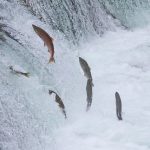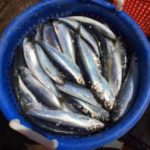Category Archives: Marine Science

NL research shows LED lights draw crab to the pot
While they stopped short of trying a tiny disco ball, a local team of researchers has proven the addition of certain light emitting diode (LED) lights will draw snow crab to offshore traps.
“Fishing enterprises could theoretically reduce bait costs through LED light substitution, or enhance existing catch rates of baited traps by simply adding an LED light,” notes their research report, now available through the journal Aquaculture and Fisheries. A team from Memorial University of Newfoundland’s Fisheries and Marine Institute, and the Department of Fisheries and Oceans completed related work in May and June 2016, with the help of the DFO base in St. John’s and, later, the fishing vessel Atlantic Champion. Click here to read the story 09:33
Letter: Taking stock of cod stock assessments
 In a Telegram letter published May 6, (“Perfectly good fisheries data being ignored,” click here ) Harvey Jarvis criticized the Department of Fisheries and Oceans’ assessments of northern cod and 3Ps (i.e. south coast) cod. Based on my 20-plus years of experience with stock assessments in Newfoundland and Labrador and other regions (Canada, the U.S., and Europe), I think Jarvis is absolutely correct about the 3Ps cod assessment, but he is incorrect about the new northern cod assessment framework that DFO adopted in 2016. Jarvis suggested that the only information used in the northern cod assessment model to estimate stock biomass is the DFO research vessel survey index. He indicated that the commercial catch, the commercial logbook data and the cod sentinel catch rate indices are not used. This is not true. The 2016 northern cod stock assessment used a state-of-the-art model,,, click here to read the letter 17:23
In a Telegram letter published May 6, (“Perfectly good fisheries data being ignored,” click here ) Harvey Jarvis criticized the Department of Fisheries and Oceans’ assessments of northern cod and 3Ps (i.e. south coast) cod. Based on my 20-plus years of experience with stock assessments in Newfoundland and Labrador and other regions (Canada, the U.S., and Europe), I think Jarvis is absolutely correct about the 3Ps cod assessment, but he is incorrect about the new northern cod assessment framework that DFO adopted in 2016. Jarvis suggested that the only information used in the northern cod assessment model to estimate stock biomass is the DFO research vessel survey index. He indicated that the commercial catch, the commercial logbook data and the cod sentinel catch rate indices are not used. This is not true. The 2016 northern cod stock assessment used a state-of-the-art model,,, click here to read the letter 17:23
Perfectly good fisheries data being ignored – Harvey Jarvis, concerned citizen
 DFO is currently under fire, from several different fronts, about recent science stock assessment estimates and the subsequent management decisions. Someone not familiar with the science assessment process might believe the federal Fisheries minister’s recent announcement to conduct cod assessments every year is way of addressing current deficiencies. It is not! Conducting full, peer-reviewed, annual assessments used to be a normal occurrence until Ottawa gutted DFO science and management at the regional level. Those annual assessments failed to prevent the cod moratorium in 1992. Simply reverting to an annual assessment process will in no way address current deficiencies. Critical to the assessment process is the mathematical model that computes biomass. Critical inputs to that model are survey indices and commercial catch. If the model is flawed or if critical inputs are not included, the assessment results will be flawed. click here to read the letter 09:37
DFO is currently under fire, from several different fronts, about recent science stock assessment estimates and the subsequent management decisions. Someone not familiar with the science assessment process might believe the federal Fisheries minister’s recent announcement to conduct cod assessments every year is way of addressing current deficiencies. It is not! Conducting full, peer-reviewed, annual assessments used to be a normal occurrence until Ottawa gutted DFO science and management at the regional level. Those annual assessments failed to prevent the cod moratorium in 1992. Simply reverting to an annual assessment process will in no way address current deficiencies. Critical to the assessment process is the mathematical model that computes biomass. Critical inputs to that model are survey indices and commercial catch. If the model is flawed or if critical inputs are not included, the assessment results will be flawed. click here to read the letter 09:37
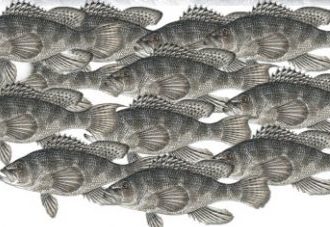
What’s so hard about managing fisheries?
Nils Stolpe/FishNet USA May 3, 2017 – “We live in a world in which data convey authority. But authority has a way of descending to certitude, and certitude begets hubris. From Robert McNamara to Lehman Brothers to Stronger Together, cautionary tales abound. We ought to know this by now, but we don’t. Instead, we respond to the inherent uncertainties of data by adding more data without revisiting our assumptions, creating an impression of certainty that can be lulling, misleading and often dangerous. Ask Clinton” Stephens, B., Climate of Complete Certainty, NY Times, 4/28/17. The above quote was from an op-ed piece by Bret Stephens, the New York Times’ recently acquired columnist. While he was targeting climate scientists, their “disciples” and the overblown pseudo-science hidden beneath an oversufficiency of less than convincing statistics that is used to strengthen their arguments, it appears that fisheries scientists are increasingly adopting the same techniques (the emphasis is mine) to support their often erroneous – sometimes sadly so – conclusions. Click here to read the article. 10:48
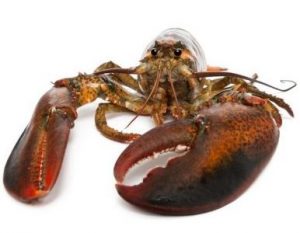
How Lobsters Do It – Mating among lobsters is a tender, human-like affair
Between their hard shells and strong pincers, American lobsters are built to fight and keep other creatures away. But does this combative, standoffish nature extend to mating? There are two general groups of animals called lobsters: clawed lobsters, which live in high-latitude, cold-water regions; and spiny lobsters, which are clawless and live in warmer sub-tropical waters. Clawed lobsters and spiny lobsters are not closely related. Clawed lobsters, including the American (Maine) and European lobsters, typically live in small, hierarchical groups, said biologist Jelle Atema, who studies American lobsters at Boston University and the Woods Hole Oceanographic Institution. Males vigorously fight each other to be the dominant male of the group, though it’s a short-lived title given that lobsters remember whom they’ve fought for no longer than a week. click here to read the story 11:24

Newfoundland and Labrador Fishermen don’t agree that crab, shrimp stocks are as bad as scientists say
The province’s fishery appears to be on the brink of a sea change. News over the past couple of months of continually declining snow crab and northern shrimp stocks in waters off Newfoundland and Labrador’s coasts have sent waves of concern washing over the fishing industry. The expected cuts this spring to crab and shrimp quotas have fisherman all around the province on edge. And there’s little else to fill in the gap — the northern cod stocks, while showing signs of strong growth in recent years, are still not ready for a major commercial fishing effort. Lying in the balance are huge investments in vessels and fishing gear, work for boat crews and plants, and the survival of rural areas of the province. But while scientific stock assessments of crab and shrimp reveal a dismal picture, many fishermen are not so sure that picture is accurate. In fact, many say they are seeing things a bit differently out on the water, and see some hope for the fishery of the future if fishermen are willing to branch out into other potential commercial species. click here to read the story 08:50
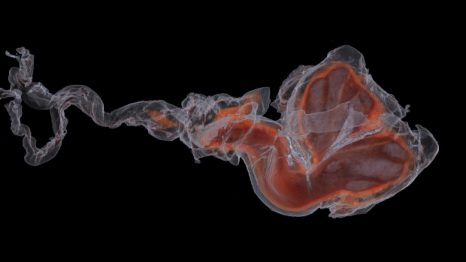
Researchers probing marine mammal genitals, copulation with simulated sex!
Dara Orbach is probably one of very few people in the world who regularly gets sent dolphin vaginas in the mail. “The boxes don’t usually smell very good when they arrive,” says Orbach, a post-doctoral fellow at Dalhousie University and a research assistant at Mount Holyoke College in Massachusetts. The marine mammologist has spent the last few years studying the genitals of whales, dolphins, porpoises, sea lions and seals to understand how they fit together during sex. It’s not an easy thing to do. First, she has to actually obtain the animals’ vaginas and penises. Orbach has a permit to receive the reproductive organs of marine mammals that have died of natural causes after a necropsy has taken place. It has taken her years, but at its peak, her collection included about 140 specimens. Second, she has to figure out how the penises and vaginas interact in real life when, in fact, they’re lying inert and disembodied on her laboratory table. click here to read this story 12:30
Scientists don’t need to do a better job of explaining themselves to fishermen — they need to do a better job of listening to them.
 There’s currently a public spotlight on the plight faced by the province’s inshore fishers, due in part to the courageous 11-day hunger strike of FISH-NL Vice-President Richard Gillett that ended Sunday with his hospitalization, and to the increasing militancy on the part of desperate fishers, who have stormed, occupied, and barricaded Department of Fisheries and Oceans (DFO) offices, burned their gear in public protest, and spoken out in myriad ways about the crisis they and their communities face.,, Their protests have provoked a range of responses, some of which are incredibly counter-productive. For instance, the suggestion that scientists need to do a better job of explaining their science to fishers.,, The implication is that if fishers actually understood the science, they would stop protesting — which misses the entire point of these protests on two counts. click here to read the article 17:45
There’s currently a public spotlight on the plight faced by the province’s inshore fishers, due in part to the courageous 11-day hunger strike of FISH-NL Vice-President Richard Gillett that ended Sunday with his hospitalization, and to the increasing militancy on the part of desperate fishers, who have stormed, occupied, and barricaded Department of Fisheries and Oceans (DFO) offices, burned their gear in public protest, and spoken out in myriad ways about the crisis they and their communities face.,, Their protests have provoked a range of responses, some of which are incredibly counter-productive. For instance, the suggestion that scientists need to do a better job of explaining their science to fishers.,, The implication is that if fishers actually understood the science, they would stop protesting — which misses the entire point of these protests on two counts. click here to read the article 17:45
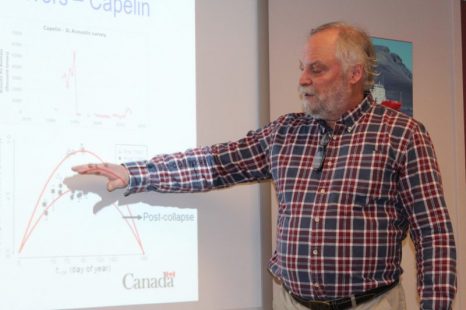
Speaking of Science, DFO says trust the science!
In the midst of ongoing protests outside of the Department of Fisheries and Oceans in St. John’s Friday, several DFO staff briefed reporters on fisheries science and the approach to resource management. At the Canadian Coast Guard building on Southside Road, they walked through an overview of ongoing scientific study and management work specific to Newfoundland and Labrador. The presentations spoke to the extent and effect of ecosystem changes, including the recent and painful quota cuts to both northern shrimp and crab. A biomathematician and employee for more than 30 years with DFO, Dr. Pierre Pepin spoke to the department’s seasonal ocean climate monitoring and trawl surveys, among other work. He said the science being conducted in the region is robust, and the reports and advice coming from DFO scientists can be trusted as a fundamental source of information. click here to read the story 09:46
Speak plain English: Scientists can do better job talking to fishermen
 Fishermen and DFO scientists may never stand on the same side when it comes to fish quotas and stocks, but the gap can — and should — be bridged, according to an academic director at Memorial University’s Fisheries and Marine Institute. “The fact that there is so much controversy is indicative that communication is a necessary component … If we’re going to find a way forward, we’re going to have to keep talking,” said Brett Favaro, director of the Fisheries Sciences program. “I think this is a really difficult situation.”,, “What we want is the next generation of researchers to be literate in communicating their science, not just — as we say — within their ivory tower … but also be able to mobilize that knowledge and engage with people in conservation groups and industry, in government, to help make that research have a direct impact on the world.” Click here to read the story 09:32
Fishermen and DFO scientists may never stand on the same side when it comes to fish quotas and stocks, but the gap can — and should — be bridged, according to an academic director at Memorial University’s Fisheries and Marine Institute. “The fact that there is so much controversy is indicative that communication is a necessary component … If we’re going to find a way forward, we’re going to have to keep talking,” said Brett Favaro, director of the Fisheries Sciences program. “I think this is a really difficult situation.”,, “What we want is the next generation of researchers to be literate in communicating their science, not just — as we say — within their ivory tower … but also be able to mobilize that knowledge and engage with people in conservation groups and industry, in government, to help make that research have a direct impact on the world.” Click here to read the story 09:32

Big Read! – The Blood of the Crab
Meghan Owings plucks a horseshoe crab out of a tank and bends its helmet-shaped shell in half to reveal a soft white membrane. Owings inserts a needle and draws a bit of blood. “See how blue it is,” she says, holding the syringe up to the light. It really is. The liquid shines cerulean in the tube. When she’s done with the show and tell, Owings squirts the contents of the syringe back into the tank. I gasp. “That’s thousands of dollars!” I exclaim, and can’t help but think of the scene in Annie Hall when Woody Allen is trying cocaine for the first time and accidentally sneezes, blowing the coke everywhere. I’m not crazy for my concern. The cost of crab blood has been quoted as high as $14,000 per quart. click here to read the article 17:58

A Shrimp That Can Kill With Sound Is Named After Pink Floyd
Legend has it that the band Pink Floyd once played so loudly at a show that the sheer volume had killed all the fish in a nearby pond. Now there’s a new species of shrimp, named after Pink Floyd, that can kill fish by making a loud noise. Synalpheus pinkfloydi rapidly opens then snaps closed its large claw, creating a sound that can reach up to 210 decibels — louder than a typical rock concert and loud enough to kill small fish nearby. It turns out, however, that its new name has nothing to do with that urban myth about Pink Floyd’s volume. Dr. Sammy DeGrave, head of research at Oxford University Museum of Natural History, says the inspiration for the shrimp’s name was really the color of its claw: pink. “The reference is to the line, ‘By the way, which one of you is Pink?’ from the song ‘Have A Cigar’,” DeGrave told NPR when reached over the phone. click to read the story 17:37
Ray Hilborn study disputes previous findings on forage fish
 A new study has been published today by a scientific group led by University of Washington fisheries researcher Ray Hilborn that disputes previous findings on the impact of human and natural predation on forage fish such as anchovies, sardines and herring. The study, published in the scientific journal Fisheries Research, found that human fishing for forage fish does not have as great an impact on the food chain as previously thought, given that humans typically catch fish of much larger size than those typically hunted and eaten by non-human species. The study also decouples the link between the size of forage fish populations and the populations of species that predate on forage fish. “What we found is that there is essentially no relationship between how many forage fish there are in the ocean and how well predators do in terms of whether the populations increase or decrease,” Hilborn said in a video explaining the study’s findings. Video, continue reading the story here 11:47
A new study has been published today by a scientific group led by University of Washington fisheries researcher Ray Hilborn that disputes previous findings on the impact of human and natural predation on forage fish such as anchovies, sardines and herring. The study, published in the scientific journal Fisheries Research, found that human fishing for forage fish does not have as great an impact on the food chain as previously thought, given that humans typically catch fish of much larger size than those typically hunted and eaten by non-human species. The study also decouples the link between the size of forage fish populations and the populations of species that predate on forage fish. “What we found is that there is essentially no relationship between how many forage fish there are in the ocean and how well predators do in terms of whether the populations increase or decrease,” Hilborn said in a video explaining the study’s findings. Video, continue reading the story here 11:47

A milestone in the war over the true state of cod
For years, fishermen from Gloucester to New Bedford have accused the federal government of relying on faulty science to assess the health of the region’s cod population, a fundamental flaw that has greatly exaggerated its demise, they say, and led officials to wrongly ban nearly all fishing of the iconic species.The fishermen’s concerns resonated with Governor Charlie Baker, so last year he commissioned his own survey of the waters off New England, where cod were once so abundant that fishermen would say they could walk across the Atlantic on their backs. Now, in a milestone in the war over the true state of cod in the Gulf of Maine, Massachusetts scientists have reached the same dismal conclusion that their federal counterparts did: The region’s cod are at a historic low — about 80 percent less than the population from just a decade ago. continue reading the story here 08:07
Great White Shark Baby Boom Expected Off Montauk
 There’s a baby boom of great white sharks expected in the coming months — and the massive mama sharks are about to head to the nursery, located off the coast of Montauk, for the big event. Last year, researchers discovered the first North Atlantic nursery for the fearsome predator in the waters off Montauk, and this year, with the baby sharks tagged, more information than ever before is available to the public, who’ve taken to avidly following the sharks on social media. Right now, according to The Virginian-Pilot, there’s a “shark party” just off the southeastern coast, with 11 sharks tagged by Ocearch.org pinging and revealing their locations via satellite. continue reading the article here 13:43
There’s a baby boom of great white sharks expected in the coming months — and the massive mama sharks are about to head to the nursery, located off the coast of Montauk, for the big event. Last year, researchers discovered the first North Atlantic nursery for the fearsome predator in the waters off Montauk, and this year, with the baby sharks tagged, more information than ever before is available to the public, who’ve taken to avidly following the sharks on social media. Right now, according to The Virginian-Pilot, there’s a “shark party” just off the southeastern coast, with 11 sharks tagged by Ocearch.org pinging and revealing their locations via satellite. continue reading the article here 13:43
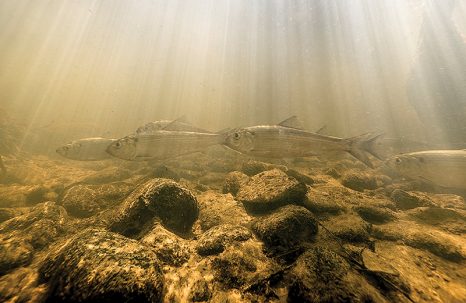
Sonar revealing more river herring in Choptank River than expected
Scientists have a powerful new tool to help them “see” fish in the Chesapeake Bay’s murky tributaries, and it’s yielding some surprisingly good news about two of the estuary’s most troubled species. “Imaging sonar” uses sound to help them view, and count, passing fish in dark or cloudy water. For the past few years, scientists with the Smithsonian Environmental Research Center have been deploying one of these underwater sound cameras in some of the Bay’s rivers to monitor spawning runs of alewife and blueback herring, collectively known as river herring.,,No one knows for sure how many river herring are in the Bay, as fisheries managers lack the staff and resources to do a comprehensive assessment. But a SERC-led team of scientists deployed an imaging sonar device in the Choptank River in 2014 that captured images of the fish as they swam by. Based on the rate at which scientists saw the shadowy blips cross their computer screens, they estimated that as many as 1.3 million river herring swam upriver that spring to spawn. That’s more than expected, and way more than state biologists had figured were there in the early 1970s, the last time anyone looked intensively at the Choptank’s herring runs. Read the article here 10:14

DFO scientist says no ‘strong indications’ seals are gobbling up all the cod
It’s a widespread belief in fishery circles, but one DFO scientist says that for now, you just can’t assume that it’s true. John Brattey says the scientific evidence does not support the notion that seal populations are hindering the rebuilding of cod stocks by gobbling up all the fish. Brattey admits it’s not easy to get good data on the diets of harp seals, but says what studies have been performed do not support the notion. Some evidence can be found just by looking at the recovery rates in the last decade, he said. continue reading the rest, click here 08:43
Measuring flounder a complex undertaking with a big impact
 It’s likely few people have written more about summer flounder than Mark Terceiro. Terceiro has published a 44-page journal article about the science, politics and litigation surrounding the species from 1975 to 2000. A 32-page follow-up covered the period from 2001 to 2010, and another article regarding developments in recent years is in the works. But it’s Terceiro’s summer flounder stock assessment update, released by the National Oceanic and Atmospheric Administration in December, that has him in the crosshairs of New Jersey politicians and recreational fishing leaders. Terceiro, a research fishery biologist at NOAA’s Northeast Fisheries Science Center, said a lot of information goes into a stock assessment. “The catch is, from both commercial and recreational, very important — that it be accurate,” Terceiro added. “We try — the government, the states — (to) go to great lengths to make sure the catch reports are as accurate as they can get.” continue reading the article here 09:20
It’s likely few people have written more about summer flounder than Mark Terceiro. Terceiro has published a 44-page journal article about the science, politics and litigation surrounding the species from 1975 to 2000. A 32-page follow-up covered the period from 2001 to 2010, and another article regarding developments in recent years is in the works. But it’s Terceiro’s summer flounder stock assessment update, released by the National Oceanic and Atmospheric Administration in December, that has him in the crosshairs of New Jersey politicians and recreational fishing leaders. Terceiro, a research fishery biologist at NOAA’s Northeast Fisheries Science Center, said a lot of information goes into a stock assessment. “The catch is, from both commercial and recreational, very important — that it be accurate,” Terceiro added. “We try — the government, the states — (to) go to great lengths to make sure the catch reports are as accurate as they can get.” continue reading the article here 09:20
UMass Dartmouth awarded $1M for scallop, flounder fisheries research
 University of Massachusetts Dartmouth scientists will receive $1 million in federal research funds to improve management of the scallop and flounder fisheries.The funding, from the National Oceanic and Atmospheric Administration Northeast Fisheries Science Center and New England Fishery Management Council Sea Scallop Research Set-Aside Program, was awarded last week to the researchers at the UMass School for Marine Science and Technology.Projects will focus on bycatch reduction, scallop biomass and improving the understanding of scallop biology. The scallop survey research will be led by Kevin Stokesbury, while Daniel Georgiana will expand on previous sea scallop gray-meat research. Link 11:51
University of Massachusetts Dartmouth scientists will receive $1 million in federal research funds to improve management of the scallop and flounder fisheries.The funding, from the National Oceanic and Atmospheric Administration Northeast Fisheries Science Center and New England Fishery Management Council Sea Scallop Research Set-Aside Program, was awarded last week to the researchers at the UMass School for Marine Science and Technology.Projects will focus on bycatch reduction, scallop biomass and improving the understanding of scallop biology. The scallop survey research will be led by Kevin Stokesbury, while Daniel Georgiana will expand on previous sea scallop gray-meat research. Link 11:51
2017-2018 Sea Scallop Research Set-Aside Recommended Awards Announced – Click here to read about the projects

Not what I’m seeing: Crab fisherman thinks stock healthier than scientists say
Port de Grave snow crab fisherman says he’s baffled by a bleak stock assessment recently released by the Department of Fisheries and Oceans. While federal scientists said there has been a whopping 40 per cent decline in the amount of harvestable crab off the coast of Newfoundland and Labrador, Dwight Petten says that doesn’t match what he is seeing on the water. Petten, 51, has been fishing for a quarter century. He and his 27-year-old son own two boats, employ six people and have a 500,000-pound quota which they caught easily in 2016. “We found catch rates the best we’ve ever had, so we’re not seeing what the scientists is saying is happening,” he told the St. John’s Morning Show. Petten, who fishes in Area 3L, from Bonavista to Cape Race, said he is seeing lots of healthy crab, despite the assertion by scientists that there are few small crab to replace the mature stock. continue reading the story here 07:51
Fish fight: Scientists battle over the true harm of mercury in tuna
 Molly Lutcavage thought she had a deal. For more than a decade, she had collected hundreds of tissue samples from bluefin tuna in hopes of settling a question that has long vexed pregnant women and the parents of young children: Should they eat the big fish, a beneficial source of protein and fatty acids? Or did mercury contamination make them too dangerous? Lutcavage hoped to test the theory that selenium, a key chemical found in tuna, prevents mercury from being transferred to the people who eat them and that, therefore, the fish are safe to eat. So she gave her hard-won samples to a colleague, Nick Fisher, to analyze in his lab. But Fisher, it seems, didn’t have as much interest in Lutcavage’s selenium theory. Two years later, he produced a study focused almost exclusively on his own hypothesis: that lowering pollution emissions from power plants reduced the levels of mercury in bluefin tuna. Lutcavage was furious, and the two scientists went to war. continue reading the article here 14:55
Molly Lutcavage thought she had a deal. For more than a decade, she had collected hundreds of tissue samples from bluefin tuna in hopes of settling a question that has long vexed pregnant women and the parents of young children: Should they eat the big fish, a beneficial source of protein and fatty acids? Or did mercury contamination make them too dangerous? Lutcavage hoped to test the theory that selenium, a key chemical found in tuna, prevents mercury from being transferred to the people who eat them and that, therefore, the fish are safe to eat. So she gave her hard-won samples to a colleague, Nick Fisher, to analyze in his lab. But Fisher, it seems, didn’t have as much interest in Lutcavage’s selenium theory. Two years later, he produced a study focused almost exclusively on his own hypothesis: that lowering pollution emissions from power plants reduced the levels of mercury in bluefin tuna. Lutcavage was furious, and the two scientists went to war. continue reading the article here 14:55

Massive Rogue Waves Aren’t Rare
University of Miami Rosenstiel School of Marine and Atmospheric Science scientist Mark Donelan and his Norwegian Meteorological Institute colleague captured new information about extreme waves, as one of the steepest ever recorded passed by the North Sea Ekofisk platforms in the early morning hours of Nov. 9 2007. Within the first hour of the day, the Andrea wave passed by a four-point square array of ocean sensors designed by the researchers to measure the wavelength, direction, amplitude and frequency of waves at the ocean surface. Using the information from the wave set—a total of 13,535 individual waves—collected by the system installed on a bridge between two offshore platforms, the researchers took the wave apart to examine how the components came together to produce such a steep wave. continue reading the article here 08:48

Study says seals eat more Chinook than Southern resident killer whales
Seals are eating more Chinook than Southern resident killer whales. That’s bad for both endangered species’ recoveries. “The seals might not be the enemy as much as the problem is that we’ve lost forage fish available to them,” said Joe Gaydos, science director of the SeaDoc Society on Orcas Island. According to a recent Canadian study, the amount of Chinook salmon eaten by seals in the Salish Sea has increased from 68 metric tons in 1970 to 625 metric tons in 2015. That’s double the amount Southern resident killer whales ate in 2015 in the same location, and six times more than commercial and recreational fisheries according to the study. Continue reading the story here 12:20
DMC researchers test technique to determine lobster’s age
 Research professor Rick Wahle and graduate student Carl Huntsberger are testing a technique at the University of Maine Darling Marine Center to determine the age of lobsters. Unlike fish, mollusks and trees, Wahle says lobsters and other crustaceans molt—or cast off their skeletons thereby discarding external signs of growth. That means a lobster’s age is estimated on size, but it’s a rough determination because ocean conditions affect the crustacean’s growth rate. Not knowing a lobster’s age is problematic for scientists and fishery managers seeking to measure the health of the fishery and the sustainability of the stock. Continue reading the story here 10:06
Research professor Rick Wahle and graduate student Carl Huntsberger are testing a technique at the University of Maine Darling Marine Center to determine the age of lobsters. Unlike fish, mollusks and trees, Wahle says lobsters and other crustaceans molt—or cast off their skeletons thereby discarding external signs of growth. That means a lobster’s age is estimated on size, but it’s a rough determination because ocean conditions affect the crustacean’s growth rate. Not knowing a lobster’s age is problematic for scientists and fishery managers seeking to measure the health of the fishery and the sustainability of the stock. Continue reading the story here 10:06
Study: Seismic Testing Disrupts Fish Behavior
 Almost anyone who’s thrown a hook in the water to catch a fish in a quiet atmosphere probably knows intuitively that loud noises spook them: you don’t scream at fish to bite, after all, you wait patiently. But intuition isn’t science, and seismic airguns don’t make just any loud noise, so when University of North Carolina Institute of Marine Sciences doctoral student Avery Paxton and some colleagues got the opportunity to do some real science on an issue that’s germane to the hot topic of oil and gas exploration by seismic surveys, they jumped at the chance. What they found, back in September 2014 when they did a study during a U.S. Geological Survey seismic mapping effort in the Atlantic Ocean off Beaufort Inlet, not only confirmed intuition, but surprised them in its degree: 78 percent of the fish on a reef near the seismic survey “went missing,” compared to counts at the same time the three previous days during the evening hours, the peak time for fish, such as snapper, grouper and angelfish, to gather there. Continue reading the article here 10:27
Almost anyone who’s thrown a hook in the water to catch a fish in a quiet atmosphere probably knows intuitively that loud noises spook them: you don’t scream at fish to bite, after all, you wait patiently. But intuition isn’t science, and seismic airguns don’t make just any loud noise, so when University of North Carolina Institute of Marine Sciences doctoral student Avery Paxton and some colleagues got the opportunity to do some real science on an issue that’s germane to the hot topic of oil and gas exploration by seismic surveys, they jumped at the chance. What they found, back in September 2014 when they did a study during a U.S. Geological Survey seismic mapping effort in the Atlantic Ocean off Beaufort Inlet, not only confirmed intuition, but surprised them in its degree: 78 percent of the fish on a reef near the seismic survey “went missing,” compared to counts at the same time the three previous days during the evening hours, the peak time for fish, such as snapper, grouper and angelfish, to gather there. Continue reading the article here 10:27

UNH researchers ID bacteria contaminating seafood in seven Atlantic coastal states and Canada.
University of New Hampshire scientists in partnership with the FDA and public health and shellfish management agencies in five states have identified a new strain of a bacterial pathogen that has contaminated seafood, sickening shellfish consumers along the Atlantic Coast at increasing rates over the last decade. N.H. Agricultural Experiment Station scientists have discovered that a Vibrio parahaemolyticus strain identified as ST631 is a predominant strain endemic to the Atlantic Coast of North America and has been traced to shellfish harvested in seven Atlantic coastal states and Canada. ST631 is the second most prevalent strain isolated from patients sickened by product sourced to the Northeast United States. Vibrio parahaemolyticus is the leading seafood-transmitted bacterial pathogen worldwide with an estimated 45,000 infections in the United States every year. It causes gastroenteritis and, rarely, lethal septicemia. The findings were announced in a letter to the editor at the Journal of Clinical Microbiology “Sequence Type 631 Vibrio parahaemolyticus, an Emerging Foodborne Pathogen in North America.” Read the story here 09:31
New scientific paper throws conventional thinking about minimum sizes for fish out the window
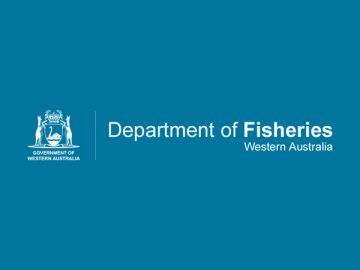 At last, after decades of so-called reviews of minimum sizes which have basically just fiddled at the edges, an Australian fisheries management authority has finally fundamentally questioned and analysed the use of minimum sizes as an effective tool for sustainable fish species management. Our friends in WA have issued Fisheries Management Paper No. 279; Policy on the Application of Fish Size Limits in Western Australia. In eight concise pages it addresses one of the oldest types of management tools used in fisheries, the setting of minimum size limits for all popular species targeted by recreational and commercial fishers. It concludes that often setting these limits is a waste of time. The Policy has then been used as the basis of the subsequent Fisheries Management Paper No. 280 which outlines proposals for reviewing the appropriateness of all current size limits that apply to finfish species in WA. Read the story here 16:03
At last, after decades of so-called reviews of minimum sizes which have basically just fiddled at the edges, an Australian fisheries management authority has finally fundamentally questioned and analysed the use of minimum sizes as an effective tool for sustainable fish species management. Our friends in WA have issued Fisheries Management Paper No. 279; Policy on the Application of Fish Size Limits in Western Australia. In eight concise pages it addresses one of the oldest types of management tools used in fisheries, the setting of minimum size limits for all popular species targeted by recreational and commercial fishers. It concludes that often setting these limits is a waste of time. The Policy has then been used as the basis of the subsequent Fisheries Management Paper No. 280 which outlines proposals for reviewing the appropriateness of all current size limits that apply to finfish species in WA. Read the story here 16:03
Price spikes for jumbo shrimp blamed on Gulf of Mexico dead zone
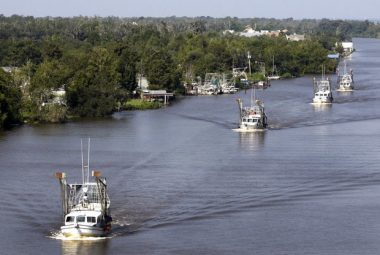 Every spring and summer when the low-oxygen dead zone forms off Louisiana’s coastline, the price of jumbo shrimp briefly spikes, affecting Gulf of Mexico fishers, consumers and seafood markets, according to a new study published Monday (Jan. 30) in the Proceedings of the National Academy of Sciences. And the price for smaller shrimp generally falls. The positive effect of the price increase on jumbo shrimp for Gulf commercial shrimpers are fleeting, however. That’s because the rise often triggers increased imports of large shrimp from foreign producers, including farm-raised shrimp, which quickly drive down prices. The dead zone is an area of low oxygen — with levels of oxygen at or below 2 parts per million — that scientists define as hypoxia. Freshwater rich in nitrogen and phosphorus from Midwest farms and from nutrient-rich sewage from cities and rural areas enters the Gulf each spring and summer, forming a freshwater layer over the Gulf’s saltier sea water. Read the full story here 18:41
Every spring and summer when the low-oxygen dead zone forms off Louisiana’s coastline, the price of jumbo shrimp briefly spikes, affecting Gulf of Mexico fishers, consumers and seafood markets, according to a new study published Monday (Jan. 30) in the Proceedings of the National Academy of Sciences. And the price for smaller shrimp generally falls. The positive effect of the price increase on jumbo shrimp for Gulf commercial shrimpers are fleeting, however. That’s because the rise often triggers increased imports of large shrimp from foreign producers, including farm-raised shrimp, which quickly drive down prices. The dead zone is an area of low oxygen — with levels of oxygen at or below 2 parts per million — that scientists define as hypoxia. Freshwater rich in nitrogen and phosphorus from Midwest farms and from nutrient-rich sewage from cities and rural areas enters the Gulf each spring and summer, forming a freshwater layer over the Gulf’s saltier sea water. Read the full story here 18:41

Study says predators may play major role in chinook salmon declines
A new study shows that increased populations of seals and sea lions are eating far more of Puget Sound’s threatened chinook than previously known, potentially hampering recovery efforts for both salmon and endangered killer whales. Seals and sea lions are eating about 1.4 million pounds of Puget Sound chinook each year — about nine times more than they were eating in 1970, according to the report, published online this month in the Canadian Journal of Fisheries and Aquatic Sciences. Most of these chinook are small fish migrating to the ocean, which ultimately reduces the number of adults returning to Puget Sound. The study estimates that seals and sea lions are decreasing potential returns by about 162,000 adult chinook each year. That’s twice the number eaten by killer whales and roughly six times as many as caught in Puget Sound by tribal, commercial and recreational fishers combined. Read the rest of the story here 21:16
In Chesapeake Bay’s changing ecosystem, blue crab is king (and moving north)
 In the face of an evolving ecosystem, experts agree many of the differences in Chesapeake Bay marine life can – at least in part – be attributed to a worldwide warming trend. Over the last three decades, water temperatures in the Chesapeake Bay have increased about 1.5 degrees Celsius, or about 2.7 degrees Fahrenheit, said Rom Lipcius, professor of marine science at the Virginia Institute of Marine Science. The change means populations of many native sea creatures in the Chesapeake have moved or expanded north in search of cooler water temperatures, and other non-native creatures have moved in. As the warming trend continues, experts say some marine species will thrive as others struggle to survive in the face of temperature, environment and predator and prey changes. “It’s not all bad news, and it’s not all good news,” said Jon Hare, science and research director for the National Oceanic and Atmospheric Administration’s Northeast Fisheries Science Center. “There are both winners and losers in this situation.” There have been a number of species, including blue crab, scup and black sea bass, that have shifted or extended northward along the Atlantic coast, said Hare. Read the story here 08:35
In the face of an evolving ecosystem, experts agree many of the differences in Chesapeake Bay marine life can – at least in part – be attributed to a worldwide warming trend. Over the last three decades, water temperatures in the Chesapeake Bay have increased about 1.5 degrees Celsius, or about 2.7 degrees Fahrenheit, said Rom Lipcius, professor of marine science at the Virginia Institute of Marine Science. The change means populations of many native sea creatures in the Chesapeake have moved or expanded north in search of cooler water temperatures, and other non-native creatures have moved in. As the warming trend continues, experts say some marine species will thrive as others struggle to survive in the face of temperature, environment and predator and prey changes. “It’s not all bad news, and it’s not all good news,” said Jon Hare, science and research director for the National Oceanic and Atmospheric Administration’s Northeast Fisheries Science Center. “There are both winners and losers in this situation.” There have been a number of species, including blue crab, scup and black sea bass, that have shifted or extended northward along the Atlantic coast, said Hare. Read the story here 08:35




































